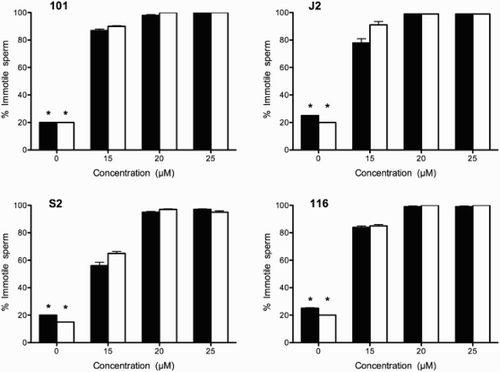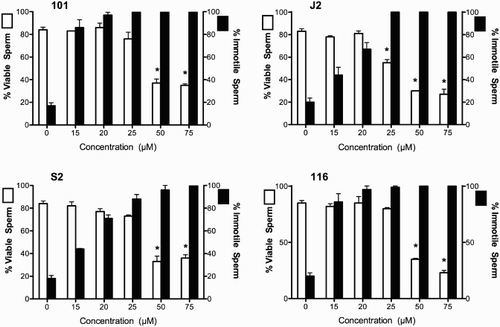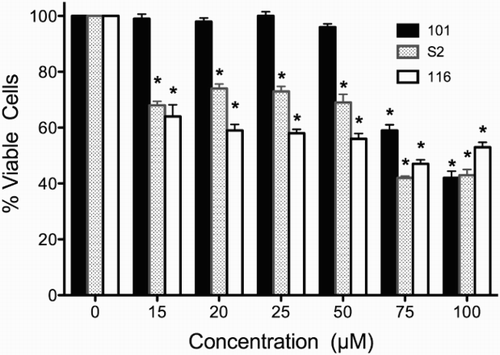Figures & data
Figure 1. The effect of disulfide compounds on sperm immobilization (A) and viability (B) in human semen samples evaluated by the method of Sander and Cramer (Citation1941). A) Semen was mixed with different concentrations of the disulfide compounds and gently vortexed for 10 sec. Then, the percentage of motile sperm was evaluated under a phase contrast microscope at 37°C. B) Sperm viability was evaluated using eosin Y staining according to the protocol outlined by the World Health Organization [WHO Citation2010]. The mean ± sem of five experiments performed with different donors is shown.
![Figure 1. The effect of disulfide compounds on sperm immobilization (A) and viability (B) in human semen samples evaluated by the method of Sander and Cramer (Citation1941). A) Semen was mixed with different concentrations of the disulfide compounds and gently vortexed for 10 sec. Then, the percentage of motile sperm was evaluated under a phase contrast microscope at 37°C. B) Sperm viability was evaluated using eosin Y staining according to the protocol outlined by the World Health Organization [WHO Citation2010]. The mean ± sem of five experiments performed with different donors is shown.](/cms/asset/451207aa-fd4f-4cb4-8c52-e57294ec9f54/iaan_a_613977_f0001_b.gif)
Table 1. Disulfide symmetric compounds.
Table 2. Disulfide asymmetric compounds.
Figure 2. The irreversible effect of the disulfide compounds on human sperm motility. Semen (black bars) was mixed with different concentrations of the disulfide compounds, and the motility recorded immediately thereafter. Control samples received 0.1% DMSO (0 µM concentration bars). The sperm was then washed with Tyrode medium (white bars) and incubated for 2 h. Motility was recorded again. The mean ± sem of three experiments performed with different donors is shown. *P < 0.001 comparing all treatments.

Figure 3. The effect of the disulfide compounds on sperm immobilization in samples resuspended in culture medium. Motile spermatozoa were selected by centrifugation through a two-step Percoll gradient, resuspended in culture medium and treated with different concentrations of the disulfide compounds for 30 min Then, the percentage of motile sperm was measured under a phase contrast microscope. The mean ± sem of eight experiments performed with different donors is shown.

Figure 4. The effect of the disulfide compounds on sperm viability and immobilization in human samples resuspended in culture medium. Motile spermatozoa were selected by centrifugation through a two-step Percoll gradient, resuspended in culture medium and treated with different concentrations of the disulfide compounds for 30 min. Control samples received 0.1% DMSO (0 µM concentration bars). Then, the percentage of viable and immotile sperm was evaluated. The mean ± sem of eight experiments performed with different donors is shown. *P < 0.01 compared with the control.

Figure 5. The cytotoxic effect of the disulfide compounds on the human cervical (HeLa) cell line. HeLa cells were incubated for 24 h with different concentrations of the disulfide compounds. Control samples received 0.1% DMSO (0 µM concentration bars). Then, cell viability was evaluated using a Cell Proliferation Assay from Promega (see Materials and Methods). The results represent the mean ± sem of five experiments. *P < 0.01 compared with the control.

Table 3. Effect of compound N,N'-dithiobisphthalimide (101) on sperm motility and HeLa cell viability.
Figure 6. The cytotoxic effect of disulfide compound 101 on the growth and survival of Lactobacillus acidophilus colonies in vitro. L. acidophilus were incubated for 24 h with different concentrations of the disulfide compound 101. Control samples received 0.1% DMSO (0 µM concentration bars). Then, the number and size of colonies were recorded. The results represent the mean ± sem of five experiments. Data are expressed as a percentage of the control, which was considered to be 100%. *P < 0.01 compared with the control.
